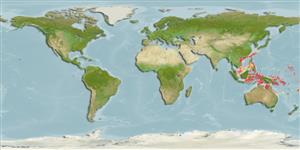Common names from other countries
>
Gobiiformes (Gobies) >
Gobiidae (Gobies) > Gobiinae
Etymology: Tryssogobius: Greek, tryo, tryso = to wear away + see under Gobius; nigrolineatus: Name from Latin 'nigro' for black and 'lineatus' for line, refers to the longitudinal black line on the postorbital head and the side of the body..
More on author: Randall.
Environment: milieu / climate zone / depth range / distribution range
Ecologia
marino demersale; distribuzione batimetrica 73 - 110 m (Ref. 75950). Tropical
Distribuzione
Stati | Aree FAO | Ecosystems | Presenze | Point map | Introduzioni | Faunafri
Western Pacific: Ryukyu Is., Fiji and Indonesia.
Size / Peso / Age
Maturity: Lm ? range ? - ? cm
Max length : 2.9 cm SL maschio/sesso non determinato; (Ref. 75950)
Short description
Chiavi di identificazione | Morfologia | Morfometria
Spine dorsali (totale) : 7; Raggi dorsali molli (totale) : 10; Spine anali: 1; Raggi anali molli: 11; Vertebre: 26. This species is characterized by the following: D VI + I, 10; A I, 11; pectoral rays 18-20; diameter of eye 2.4-2.7 in HL; narrow interorbital width, 6.7-8.15 in HL; first 3 dorsal spines subequal, the longest 2.4-3.65 in SL; caudal fin rhomboid, 2.6-3.5 in SL; pectoral fins 3.4-3.6 in SL; colour light grey with a midlateral blackish line from behind eye to posterior caudal peduncle; blackish first dorsal spine, a yellow line at base of fin; second dorsal and caudal fins with 2 rows of yellow spots, anal fin with 1 row; yellow line in middle of caudal fin (Ref. 75950).
Inhabits sand and rubble bottoms of outer reef slopes in 50-110 m (Ref. 90102). All specimens were collected by handnets from at depths of 73-110 m off Viti Levu, while diving with mixed-gas rebreather gear (Ref. 75950).
Life cycle and mating behavior
Maturities | Riproduzione | Spawnings | Egg(s) | Fecundities | Larve
Randall, J.E., 2006. Three new species of the gobiid fish genus Tryssogobius from the western and South Pacific. Aqua, 11(3):105-116. (Ref. 75950)
IUCN Red List Status (Ref. 130435)
CITES (Ref. 128078)
Not Evaluated
Threat to humans
Harmless
Human uses
Strumenti
Special reports
Download XML
Fonti Internet
Estimates based on models
Preferred temperature (Ref.
115969): 20.2 - 27.1, mean 25.9 (based on 40 cells).
Phylogenetic diversity index (Ref.
82804): PD
50 = 0.5078 [Uniqueness, from 0.5 = low to 2.0 = high].
Bayesian length-weight: a=0.01023 (0.00477 - 0.02194), b=3.02 (2.84 - 3.20), in cm Total Length, based on LWR estimates for this (Sub)family-body shape (Ref.
93245).
Trophic level (Ref.
69278): 3.1 ±0.3 se; based on size and trophs of closest relatives
Resilienza (Ref.
120179): Alto, tempo minimo di raddoppiamento della popolazione meno di 15 mesi (Preliminary K or Fecundity.).
Fishing Vulnerability (Ref.
59153): Low vulnerability (10 of 100).
